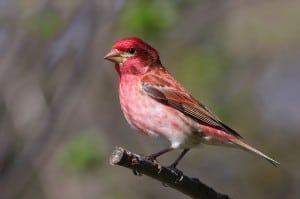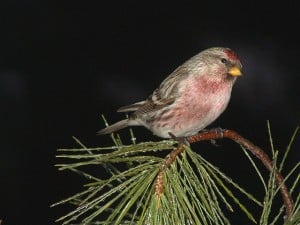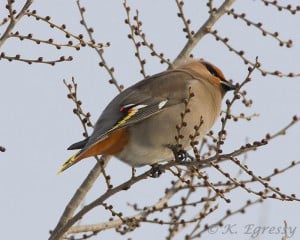Late September through to the end of October is usually the busiest time of year at my backyard feeders. This year is no exception. At least two dozen White-throated Sparrows, along with lesser numbers of White-crowned Sparrows, Dark-eyed Juncos, Blue Jays, House Finches, American Goldfinches, Northern Cardinals and Black-capped Chickadees have already put a serious dint in my annual birdseed budget. The White-throats and White-crowns are especially entertaining to watch as they scratch for the millet I scatter on the lawn. Both species kick aside leaf litter and grass with a comical backward motion of the legs. My wife and I are always on the lookout for some of the rarer species that turn up during fall migration, as well. Last week a beautifully-marked male Eastern Towhee dropped by for several hours, and this past Sunday we were treated to a visit by the thrush-like Fox Sparrow.
After the sparrows depart in late October for their wintering grounds in the mid-and southeastern U.S., feeder activity slows dramatically, at least until a less reliable second act of birds arrive. These are the so-called “winter finches,” nomads from the north that may turn up one year but be totally absent the next. The species involved include Purple Finch, Common and Hoary Redpolls, Pine Siskins, Pine and Evening Grosbeaks and both Red and White-winged Crossbills. Why is it that finch numbers fluctuate so widely? The short answer is food.
Winter finches move southward – or east or west, for that matter – when there is a shortage of wild food in their breeding territories in the boreal forest of northern Ontario and Quebec. The wild foods the birds depend upon most are the seeds and berries of deciduous and coniferous trees such as birches, mountain-ashes, pines and spruces. If seed crops are good in the north, the birds stay put. If food is lacking, they will sometimes fly thousands of kilometres to find it. Whether they actually choose to spend the winter here in central Ontario and the Kawarthas depends mainly on the abundance of wild food crops here.
Since the fall of 1999, Ron Pittaway of the Ontario Field Ornithologists has prepared an annual forecast of what winter finch species are most likely to make an appearance in southern and central Ontario during the upcoming fall and winter. The forecast is based on information he collects on the relative abundance of seed crops in the boreal forest. Much of the data comes from Ministry of Natural Resources staff. So, what is the seed crop situation this year and what are the implications for the thousands of Peterborough area residents who enjoy feeding the birds? Below you will find a species by species breakdown. Although not finches, three other bird species are included in the list, namely the Blue Jay, Red-breasted Nuthatch and Bohemian Waxwing. Their numbers in a given winter are often linked to those of the boreal finches.
PINE GROSBEAK: This, our largest finch, should move south in small numbers. The American mountain-ash berry crop is below average across the boreal forest this year, which means that the crop may become depleted forcing grosbeaks southward. If Pine Grosbeaks come south, they will find plenty of European Mountain-ash berries and ornamental crabapples in the Kawarthas and elsewhere in central and southern Ontario. They will sometimes come to feeders, too, if sunflower seeds are available.
PURPLE FINCH: Some Purple Finches should show up this winter because of low seed crops in the north. Purple Finches winter in numbers in the north only in years of bumper seed crops. An easy way to tell Purple Finches from House Finches is by checking the tip of the tail; it is distinctly notched or slightly forked in Purple and squared off in House Finch. Purples prefer sunflower seeds at feeders.
RED CROSSBILL: Expect a scattering of Red Crossbills in central Ontario this winter. The species was seen this summer in the “pine belt” of northeastern Algonquin Park and should remain there for the winter. Some may also appear elsewhere in Algonquin Park and in areas of the Kawarthas such as Petroglyphs Provincial Park.
WHITE-WINGED CROSSBILL: This crossbill moves back and forth like a pendulum across the boreal forest looking for bumper spruce cone crops. It irrupts south only in years of widespread cone crop failures. They will be scarce in most of Ontario because cone crops are low. Many of the spruce in the Kawarthas, however, have abundant cones, so it should be interesting to see if at least some White-wings show up here.
PINE SISKIN: This is another species that depends on the seeds they extract from spruce cones. A low White Spruce cone crop in most of Ontario probably means that very few of these birds will choose to winter here, unless the Kawarthas is an exception. At feeders, siskins prefer nyger seeds in silo feeders.
COMMON REDPOLL: Similar to last winter, expect a southward movement of redpolls. Birch seed crops are low to average across the boreal forest, so they’ll be looking for food elsewhere. Seed abundance is much better in central and southern Ontario, so watch for redpolls in birches and even in weedy fields. At feeders, redpolls prefer the same seeds as siskins, namely nyger seeds served in silo feeders. Hoary Redpolls, which are paler and larger, are often mixed in with flocks of Common Redpolls.
EVENING GROSBEAK: Breeding numbers have been building in Quebec. This is linked to a greater food supply from increasing outbreaks of spruce budworms, so a small southward flight of this spectacular grosbeak is likely. The feeders at the Visitor Centre in Algonquin Park usually have grosbeaks in winter. Evening Grosbeaks prefer black oil sunflower seeds.
BLUE JAY: The flight of southbound jays is fairly strong this year along the north shorelines of Lakes Ontario and Erie, meaning large numbers of the birds are heading to the U.S. for the winter. The number of jays that tough it out in Ontario in a given winter appears to be linked to the size of acorn, beechnut and hazelnut crops. Acorn crops this year were good in some areas but poor in others. The beechnut crop failed in most of Ontario and the hazelnut crop was only average. As for the Kawarthas, the acorn crop appears quite good, so maybe these gorgeous but taken-for-granted birds will stick around in healthy numbers, at least locally.
RED-BREASTED NUTHATCH: Very few of these nuthatches are moving south this year, which means that White-winged Crossbills and Pine Siskins are unlikely to show up, either. A heavy cone crop on Balsam Fir in many areas may explain why Red-breasts are happy to stay put this year.
BOHEMIAN WAXWING: Expect a moderate southward and eastward flight this winter. This is because American Mountain-ash berry crops are only average in the boreal forest. Bohemians now occur annually in central and southern Ontario, whereas historically their appearance here was far less frequent. Their more regular winter occurrence may be related to the abundance of introduced European Buckthorn trees, which produce large berry crops almost every year. If they venture south, Bohemians will also find large crops on European Mountain-ash and ornamental crab apples in many areas, including the Kawarthas. They can be distinguished from Cedar Waxwings by their rufous undertail feathers, yellow tips on wing feathers and dark grey belly.
To conclude, it looks like a fairly good winter for backyard birds, with a nice variety of species likely to show up. If you haven’t done so already, get your feeders out now and stock up on black oil sunflower, nyger and millet seeds. The birds will thank you for it and the winter will seem a little shorter!
Sidebar: Project FeederWatch Needs Your Help!
At regular intervals from November to April, thousands of FeederWatchers count the kinds and numbers of birds at their feeders, then submit their observations to Bird Studies Canada. This information helps scientists study winter bird populations. Project FeederWatch participants receive a full-colour bird poster and calendar, a FeederWatch Handbook and Instruction Book, access to the data entry portion of the FeederWatch website, and the chance to contribute to a continent-wide bird research project. Visit birdscanada.org for more information


